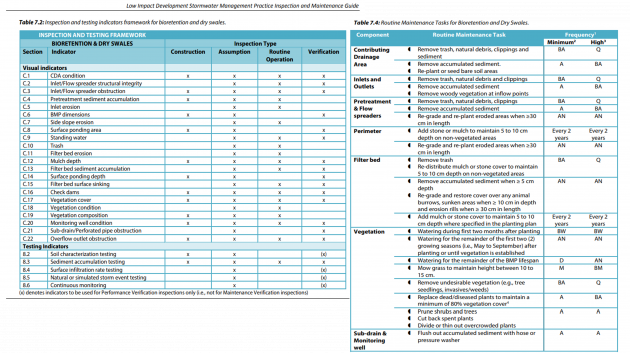Inspection and maintenance
Overview[edit]
Integration of Low Impact Development (LID) best management practices (BMPs) into stormwater management (SWM) systems is widely advocated to better address the potential stormwater-related impacts of urbanization on the health of receiving waters. A substantial amount of guidance is available on the planning and design of LID BMPs (CVC & TRCA, 2010)[1] and their construction ([https://cvc.ca/wp-content/uploads/2013/03/CVC-LID-Construction-Guide-Book.pdf CVC, 2012)[2] and some municipalities and conservation authorities commonly require them to be a part of new SWM systems.
However, even with sound design, LID BMPs may not provide the intended level of treatment if they are not installed properly or protected from damage during construction. Experiences with early applications have shown that failures are often due to: Practices not being constructed as designed or with specified materials; Lack of erosion and sediment controls (ESCs) during construction; and/or Lack of rigorous inspection prior to assumption. A 2009 survey of stormwater BMPs in the James River watershed (Virginia) by the Center for Watershed Protection found approximately half (47%) of the 72 BMPs deviated in one or more ways from the original design, or were receiving inadequate maintenance (CWP, 2009). Similar results have been revealed from surveys of stormwater detention ponds in Ontario (Drake et al., 2008; LSRCA, 2011), highlighting the need for thorough inspections of BMPs prior to assumption and a proactive approach to stormwater infrastructure operation and maintenance. Therefore, it is important to conduct timely inspections during construction and detailed inspection and testing prior to assumption to ensure that LID BMPs are: Built according to approved plans and specifications; Installed at an appropriate time during overall site construction and with protective measures to minimize risk of siltation or damage; and Fully operational and not in need of maintenance or repair at the time of assumption by the property owner or manager. Like all stormwater BMPs, LID practices are designed to retain pollutants carried by urban runoff and all have a finite capacity to perform this function in the absence of maintenance, until their treatment performance declines or they no longer function as intended. Their functional and treatment performance will only be sustained over the long term if they are adequately inspected and maintained. Under the Ontario Water Resources Act, provincial approvals for SWM facilities and BMPs (i.e., Ontario Ministry of the Environment and Climate Change’s Environmental Compliance Approvals process) typically make the property owner responsible for all inspection and maintenance tasks and associated record keeping (Zizzo et al., 2014). A proactive, routine inspection and maintenance program will also:
LID Practices' Inspection & Maintenance[edit]
Inspection & Maintenance Terminology[edit]
Life Cycle and Inspection[edit]
- Copy of McMaster Training course and link to the course
Training Requirements[edit]
Key Considerations During BMP Design and Planning[edit]
Testing[edit]
External Links[edit]
Embedded Guide[edit]
This guide is focused on planning and design. In many places you will find tips to design structures with considerations for how to facilitate future maintenance.
But to get detailed information from STEP on the inspection and maintenance of LID practices, please see our complete guide here or embedded below:
References[edit]
- ↑ CVC and TRCA. 2010. Low impact Development Stormwater Management Planning and Design Guide. Version 1.0. https://sustainabletechnologies.ca/app/uploads/2013/01/LID-SWM-Guide-v1.0_2010_1_no-appendices.pdf
- ↑ CVC. 2012. Low Impact Development Construction Guide. Version 1.0. https://cvc.ca/wp-content/uploads/2013/03/CVC-LID-Construction-Guide-Book.pdf
